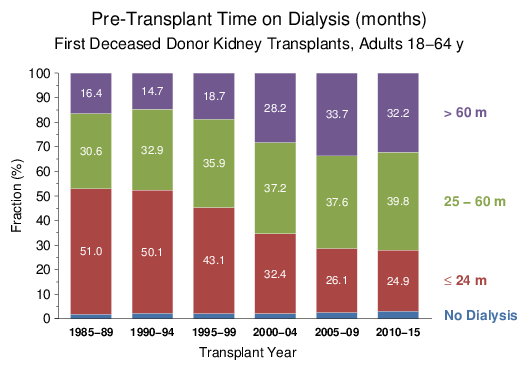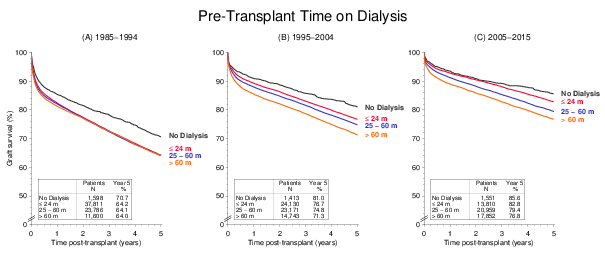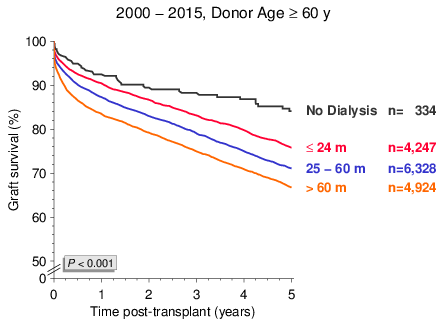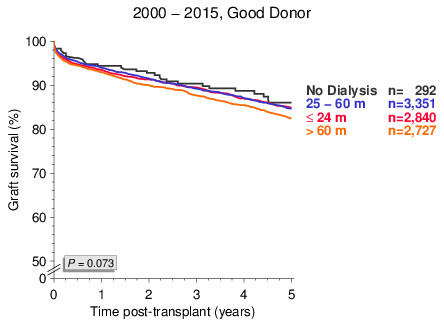
Figure 1
CTS Collaborative Transplant Study
Dear Colleague
We are starting 2018 with our best wishes and thanks for your continued support.
Some 30 years ago, in the CTS Newsletter 5:1987, we shared with you a CTS analysis which showed a lack of influence of pre-transplant duration of dialysis on the survival of kidney grafts. In contrast, fifteen years later in the year 2002, Meier-Kriesche and Kaplan, who analyzed transplantations performed during 1988 – 1998, reported that the time on dialysis is the strongest modifiable risk factor for renal transplant outcomes (Transplantation 74: 1377). We found it now of interest to investigate the features of the time-on-dialysis effect in more detail to possibly find an explanation for the discrepancy between these two previous reports.
As illustrated in Figure 1, pre-transplant time on dialysis tended to increase over the years. During 1985 – 1994, approximately 50 % of adult recipients of first deceased donor kidney transplants spent less than 24 months on dialysis. This fraction decreased to approximately 25 % during the last 10 years.

Figure 1
The relationship between time on dialysis and kidney graft survival is illustrated for three consecutive time intervals in Figure 2. More than 190,000 adult (18 – 64 year old) recipients of first deceased donor kidney transplants were studied. Prior to 1995, with the exception of a superior outcome in patients transplanted preemptively, no differences were noted between the three dialysis-time categories analyzed. Interestingly, coinciding with a striking improvement of graft survival rates during 1995 – 2004, a beneficial impact of shorter pre-transplant dialysis time became evident. Patients who received a preemptive transplant continued to demonstrate superior graft outcome. As graft survival rates improved further during 2005 – 2015, patients with a short dialysis time of ≤ 24 months approached patients with preemptive transplantation.

Figure 2
Because important confounders such as the age of the donor also have changed dramatically over the years, multivariable Cox regression analysis was performed with all influential confounders, including recipient and donor age. Calculated hazard ratios (HR) for 5-year graft survival with 95 % confidence intervals (CI) and corresponding P-values are shown in Table 1. The same time periods (years of transplantation) and dialysis-time categories in months were used as in Figure 2, whereby the ≤ 24 months category served as reference (HR = 1.0). The analysis impressively confirmed that the negative impact of prolonged pre-transplant dialysis on graft survival became more evident over the years, whereas the difference between the influence of a short dialysis time (≤ 24 months) and preemptive transplantation diminished.
|
Dialysis Time |
1985 – 1994 |
1995 – 2004 |
2005 – 2015 |
|
No Dialysis |
0.83 (0.76–0.92) |
0.87 (0.76–0.99) |
0.92 (0.79–1.07) |
|
≤ 24 months |
1.00 |
1.00 |
1.00 |
|
25 – 60 months |
1.02 (0.99–1.04) |
1.09 (1.05–1.14) |
1.19 (1.12–1.26) |
|
> 60 months |
1.03 (0.99–1.07) |
1.27 (1.21–1.33) |
1.39 (1.31–1.48) |
Table 1
In the Cox regression analysis, a significant interaction was observed between the confounders pre-transplant dialysis time and donor age. Figure 3 shows that there is a very strong gradual impact of dialysis time on graft survival in more recently performed transplantations if the patient receives an organ from a ≥ 60 year old donor.

Figure 3
However, the effect of pre-transplant dialysis time disappears almost completely in an analysis of transplants performed during recent years if the analysis is limited to recipients of organs from ‘good donors’. In the analysis shown in Figure 4, recipients of organs from ≥ 60 year old donors or donors with a poor HLA match (5 – 6 HLA-A+B+DR mismatches), > 18 hours of cold ischemia or death due to a cerebrovascular event were excluded.

Figure 4
In recipients of kidneys from ≥ 60 year old donors, pre-transplant dialysis exceeding 60 months is associated with an almost 50 % higher risk of graft loss after 5 years as compared to the ≤ 24 months reference category (HR = 1.48; 95 % CI 1.36 – 1.62, P < 0.001) and a more than two-fold higher risk as compared to preemptive transplantation without dialysis (HR = 2.08; 95 % CI 1.54 – 2.81, P < 0.001). These results are compatible with a hypothesis that organs from older donors are more vulnerable to immune attack that is pronounced in patients with prolonged dialysis due to longer contact with artificial membranes, foreign HLA and infectious agents. Accordingly, the increasing impact of pre-transplant dialysis duration from the early 1980’s is primarily explained by the strong increase in donor age in recent years (CTS Newsletter 3:2014).
As always at the start of the year, the outcome graphs on the CTS website (www.ctstransplant.org) have been updated and moved forward one year to keep them as current as possible. In addition, your own center’s graphs have also been updated with each quarterly cycle so that the most recently reported follow-up data are included with minimal delay. The analysis of your own center’s data, of course, can only be as good as the data you provide. Incomplete documentation often results in inadequate center statistics. Please document as completely as possible in your own interest and to help maintain the high quality of the CTS registry.
The next shipping date for the DNA and serum studies is June 18/19, 2018.
We wish you all a peaceful year 2018!
Sincerely yours,
![]()
Caner Süsal